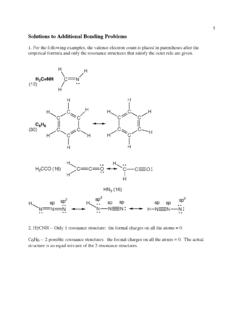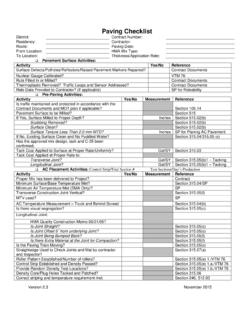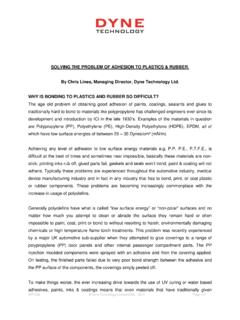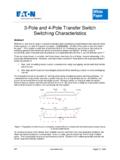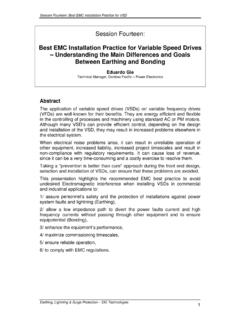Transcription of Study Suggestions for HESI Pre-Admissions Test
1 hesi A2 Study Recommendations Rev 12/08 CPM 1 Study Recommendations for hesi Admissions Assessment Test additional materials are available to prepare for the hesi A2 Test: Recommended PLATO tutorials at end of this document The Learning Express Library accessible from the LInC Databases webpage- Sign in and click on Nursing under Featured Resources. Take the Nursing School Practice Entrance Tests 1 & 2 for Biology, Chemistry, Math and Reading Comprehension. The hesi admission Assessment Exam Review book is: o Available in the LInC, On Reserve (you can look at it and take notes, but you cannot check it out, and you cannot copy any pages). o Available from bookstores; approximate price $ (plus shipping & handling). Be SURE to ask for hesi (evolve/reach) admission Assessment Exam Review, ISBN 9781416056355 Can also be purchased from this website: BIOLOGY Please refer to your textbooks used in BIOL 105 (formerly BIOL100) and your Anatomy & Physiology courses.
2 Properties of Water (an Inorganic Compound) Polarity of Molecules Biological Molecules ("Organic Compounds"): Carbohydrates, including glycogen and starch Lipids Saturated vs. Unsaturated Fats Phospholipids Steroids Proteins Structural (Fibrous) vs. Functional (Globular, including Enzyme) Proteins Nucleic Acids: DNA and RNA Enzymes as Catalysts for Metabolic Processes ATP Cell Structure and Function Nucleus Chromosomes (Chromatin) Ribosomes Endoplasmic Reticulum (ER): Rough ER Smooth ER hesi A2 Study Recommendations Rev 12/08 CPM 2 Gogi Apparatus Lysosomes Inclusions (Vacuoles) Mitochondria Plasma (Cell) Membrane Proteins of the Cell Membrane and their functions Cytoplasm Cytoskeleton Diffusion Osmosis Filtration (Asexual) Cellular Growth and Reproduction (see also "Binary Fission," for bacteria, below) Mitosis: interphase, prophase, metaphase, anaphase, telophase cytokinesis Sexual Cellular Reproduction: Meiosis.
3 Meiosis I and Meiosis II Genetic Code DNA A, T, G and C nitrogenous bases Double Helix structure Replication Transcription Translation: Codon Anticodon . Necessary Life Functions (Characteristics of Cells/Living Organisms) Homeostasis Positive Feedback versus Negative Feedback Metabolism: Anabolism Catabolism Cellular Respiration: Aerobic: Glycolysis Kreb s Cycle: NADH, FADH2 Electron Transport Chain Anaerobic (Fermentation) hesi A2 Study Recommendations Rev 12/08 CPM 3 The following topics may not be found in your Human Anatomy & Physiology texts, but may be reviewed using the listed web links. Genetics: Genotype versus Phenotype Dominant and Recessive Traits Alleles Homozygous vs. Heterozygous Traits Punnett Squares: Pedigree Polygenes and Environmental Factors (Multifactorial Inheritance) Organization of Species: Know all Kingdoms, including Monera (bacteria) and Animalia (includes humans) This site will help you understand the Kingdoms.
4 It is a bit confusing to Study this topic at this time, as science is in a transitional stage of re-classifying all living creatures, due to recent new information. Understand that the single-celled bacteria (former Kingdom Monera) belong to the Prokaryotes, and differ from the Eukaryotes (which include most plants and all animals, including humans). Note that the term "Prokaryote," which you may understand to be basically single-celled bacteria, is not mentioned at the first site below, but is understood to be the combination of Archea and other being on earth is in the Domain Eukarya, and is thus a Eukaryote. The second site listed below will also be helpful, as it distinguishes the characteristics of Eukaryotes from those of the Prokaryotes. #kingdoms Theory of Evolution: Scientific Method: Density: Specific Heat: ~cpanhd/C101webnotes/matter-and- Solutions: click on Terms Solution Composition and Problems and Solutions hesi A2 Study Recommendations Rev 12/08 CPM 4 Photosynthesis and Chloroplasts: Describe the basic chemical equation: Binary Fission: a type of Asexual Cellular Reproduction used by bacteria, not humans The method by which bacteria reproduce.
5 The circular DNA molecule is replicated; then the cell splits into two identical cells, each containing an exact copy of the original cell's DNA. CHEMISTRY The following topics are may not be found in your Human Anatomy & Physiology texts, but may be reviewed using the listed web links. States of Matter, and Changes of State of Matter: Solid, Liquid and Gas Mixtures: Homogeneous versus Heterogeneous ~cpanhd/C101webnotes/matter-and- Atomic Structure: Protons, Electrons, Neutrons: mass, location and charge of each Orbitals versus Nucleus of Atom Atomic Number Atomic Mass Isotopes Ions: Cations versus Anions Chemical Bonding: Covalent versus Ionic Polar versus Nonpolar Covalent Bonds Single-, Double-, and Triple-Covalent Bonds Hydrogen Bonding http: Click on Sparknotes Free Study Guide tab (top left corner) Click on Study Guide Category Chemistry Select topic from items in Bonding list Acids and Bases.
6 Characteristics of Acids Characteristics of Bases Neutralization hesi A2 Study Recommendations Rev 12/08 CPM 5 pH scale Chemical versus Physical Changes/Properties ~cpanhd/C101webnotes/matter-and- Periodic Table of Elements: ~cpanhd/C101webnotes/ A Periodic Table to print out, when reading about "Trends," below: Characteristics of Groups and Rows in the Periodic Table, including Ions and Noble Gases Trends in the Periodic Table: Chemical Equations: Reactants versus Products ~cpanhd/C101webnotes/chemical%20 Chemical Reactions: synthesis, decomposition, combustion (oxidation-reduction, or "redox"), single- and double- exchange (or replacement, or displacement) Rates of Chemical Reactions Reversible versus Irreversible Reactions Effects Due to Changes in: Temperature, Particle Size (Surface Area), Concentration of Reactants, Addition of a Catalyst Moles: Definition Molar Calculations: Calculation of number of molecules of a substance, given the number of moles; Calculation of number of grams of a substance, given the number of moles of that substance.
7 Calculate the number of moles of a substance, given the weight in grams: Nuclear Chemistry: radioactivity, and release of alpha, beta and gamma radiation hesi A2 Study Recommendations Rev 12/08 CPM 6 Law of Conservation of Matter (Mass): ~cpanhd/C101webnotes/matter-and- ~cpanhd/C101webnotes/chemical%20 Van der Waals Forces: Stoichiometry: Balancing simple chemical equations Oxidation States: Definition: An oxidation number (oxidation state) is the charge an atom would carry if the molecule or ion were completely ionic Rules for Determining Oxidation States: For elements, the oxidation number is the number of electrons the element would have to lose or gain in order to have a complete outer shell. ( , Oxygen would be assigned "-2" as it would have to accept two additional negatively charged electrons to complete its outer shell).
8 ANATOMY & PHYSIOLOGY The following information can be found in your Anatomy & Physiology texts. Homeostasis Levels of Structural Organization (cells to organisms) Directional Terms: Superior, inferior, anterior, posterior, medial, lateral Planes of the Body: Median (Sagittal), Coronal (Frontal), Transverse (Horizontal) Body Cavities (Know location and organ contents): Dorsal: cranial and spinal Ventral: orbits, nasal, oral, thoracic, mediastinum, pericardial, pleural and abdominopelvic (peritoneal) Membranes of Body Cavities (pleural, pericardial, peritoneal) Know the Four Major Tissues and the Function of Each: Epithelial Tissue: Types of Membranes and their Definitions: hesi A2 Study Recommendations Rev 12/08 CPM 7 Mucous, Serous, Synovial and Cutaneous Connective Tissues: Cartilage, Bone, Blood, Adipose, Dense, Loose Muscle Tissue.
9 Voluntary and involuntary; smooth, cardiac and skeletal Nerve Tissue Glands: sudoriferous, sebaceous, ceruminous Review of Parts (Organelles) of the Cell (see listing under Biology, above) Integumentary System Epidermal and Dermal Structures What is keratin, and keratized epithelium? Strata of the Epidermis: stratum corneum, stratum lucidum, stratum granulosum and stratum germinativum/basale (mitotic layer) Subcutaneous Tissue (Hypodermis): know definition Sebaceous and Sudoriferous Glands Functions of the Skin Appendages of the Skin: hair, nails Skeletal System Functions of the skeletal system Classification of bones by shape Osteocytes/Osteoblasts/Osteoclasts Spongy versus Compact bone Axial versus Appendicular bones Number of bones in the body, Names of all the bones and numbers of each type (including numbers and types of vertebrae, names and numbers of cranial bones, facial bones).
10 Term to Know: foramen magnum and its significance Muscular System Organization: muscles, muscle cell, myofibrils, myofilaments, sarcomeres Sliding Filament Theory of Muscle Contraction: role of actin, myosin, ATP, calcium Muscle Types: Voluntary versus Involuntary versus Cardiac Prime Mover, Agonists, Antagonists Classification of Muscles as Flexors, Extensors, Abductors, Adductors Naming of Muscles Related to location, origin, insertion, shape, function (action) Know the names of all major contour (surface) muscles of body. Terms to Know: Joint, Tendon, Ligament, Sarcoplasmic Reticulum hesi A2 Study Recommendations Rev 12/08 CPM 8 Nervous System Basic Functions Anatomy of Neuron Conduction of a Nerve Impulse through the Neuron Sensory (afferent) versus Motor (efferent) Neurons Central Nervous System versus Peripheral Nervous System Somatic (Voluntary) Nervous System versus Autonomic Nervous System Major Parts of the Brain (cerebrum, cerebellum, medulla oblongata) and their Functions Spinal Cord and Spinal Nerves: Simple spinal reflexes versus reflexes modified by ascending and descending tracts Sensory versus motor impulses Dorsal horns versus ventral horns Definitions.
